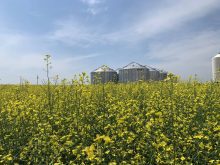Harvest is a rewarding time of year for farmers. There is nothing more satisfying than having all that hard work result in a successful and bountiful harvest. However, a combine fire can put all of that work and your safety in danger. A combine fire can mean lost time, property damage or worse — severe injury or even a loss of life.
Combines can become fire hazards if not properly maintained. A fire only needs three things to ignite: oxygen, a heat source, and material to burn. When you consider dry fields, high winds, hot machines, and crop dust and straw, it’s no wonder these machines can catch fire.
Read Also

Claas brings 1000 Series SP forage harvesters to Canada
In mid-August, Claas unveiled its new line of Jaguar forage harvesters at an event in Visalia, California, deep in the heart of that state’s dairy region.
One of the most effective ways to prevent a combine fire is by simply taking the time to clean the machine.
Many farmers make sure to thoroughly clean their machines either before or after harvest. The reality is that cleaning your combine once a year simply isn’t enough to prevent a fire. It’s important to take the time to clean your combine routinely to prevent the build-up of crop debris, which can lead to machine breakdowns or a costly fire.
First, remember never to clean or unplug the machine with the engine running. Make sure to disengage the drives, turn off the engine and remove the key. It’s essential to wait for all movement to stop before leaving the operator’s seat.
There are a few key areas to inspect and clean on your combine. They include batteries, feeder area, engine compartment, rotor covers, ground drive transmission, chopper area, tailings housing, frame ledges and wire harness. Regular inspection and cleaning of these specific areas provide the greatest impact in reducing fire hazards.
Using a leaf blower or compressed air can make cleaning much easier. Remember to use these air blowing tools in a fire-safe area, away from any flammable materials (including fields). The quick-moving air may ignite any hot particles resulting in a fire. Make sure to wear the proper gear when using compressed air including eye protection and a face mask to protect your eyes and lungs.
It’s also important to stop and check for crop debris buildup throughout the day. Certain crops are prone to excess buildup on your combine, if this is the case, inspections and cleaning should be performed more often. Pausing to clean out the machine may seem like a waste of time, but a few moments of cleaning can save you a burnt combine, a ruined crop, and months of lost time. The more residue you can remove from the machine, the safer and less prone to burning it will be.
In addition to cleaning procedures, there are some key components that you need to think about when you’re trying to avoid combine fires:
- Check coolant and oil levels daily. Running low on either of these things can cause your combine to heat up and put you in a risky situation.
- Ensure bearings, belts, or other moving parts that can get extremely hot aren’t surrounded or wrapped up by plant material.
- Repair leaky fuel or oil hoses, fittings or metal lines immediately.
- Wait at least 15 minutes before filling the machine with fuel to lower the risk of spilled fuel on a hot machine.
- Keep at least one fire extinguisher in the cab of the combine and a second outside the machine at ground level. (Check them daily to make sure they continue to work well.)
- Stop the combine and clean out debris frequently throughout the day. Dry, hot and windy conditions can add to the build-up of debris, so it’s important to check the danger zones for blockages.
If a fire arises after these precautions, call emergency services first. Once the fire department has been called, attack with the fire extinguisher if it’s safe to proceed. In a dry, windy environment, fires can double in no time and expand well beyond your control.
Contact your dealer and read your manual for specific instructions for your combine. Have a safe and productive harvest!















